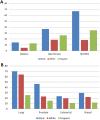Perceptions of Cancer Care and Clinical Trials in the Black Community: Implications for Care Coordination Between Oncology and Primary Care Teams
- PMID: 28706009
- PMCID: PMC5599206
- DOI: 10.1634/theoncologist.2017-0122
Perceptions of Cancer Care and Clinical Trials in the Black Community: Implications for Care Coordination Between Oncology and Primary Care Teams
Abstract
Background: Despite efforts to ameliorate disparities in cancer care and clinical trials, barriers persist. As part of a multiphase community-engaged assessment, an exploratory community-engaged research partnership, forged between an academic hospital and a community-based organization, set out to explore perceptions of cancer care and cancer clinical trials by black Bostonians.
Materials and methods: Key informant interviews with health care providers and patient advocates in community health centers (CHCs), organizers from grassroots coalitions focused on cancer, informed the development of a focus group protocol. Six focus groups were conducted with black residents in Boston, including groups of cancer survivors and family members. Transcripts were coded thematically and a code-based report was generated and analyzed by community and academic stakeholders.
Results: While some participants identified clinical trials as beneficial, overall perceptions conjured feelings of fear and exploitation. Participants describe barriers to clinical trial participation in the context of cancer care experiences, which included negative interactions with providers and mistrust. Primary care physicians (PCPs) reported being levied as a trusted resource for patients undergoing care, but lamented the absence of a mechanism by which to gain information about cancer care and clinical trials.
Conclusions: Confusion about cancer care and clinical trials persists, even among individuals who have undergone treatment for cancer. Greater coordination between PCPs and CHC care teams and oncology care teams may improve patient experiences with cancer care, while also serving as a mechanism to disseminate information about treatment options and clinical trials.
Implications for practice: Inequities in cancer care and clinical trial participation persist. The findings of this study indicate that greater coordination with primary care physicians (PCPs) and community health center (CHC) providers may be an important step for both improving the quality of cancer care in communities and increasing awareness of clinical trials. However, PCPs and CHCs are often stretched to capacity with caring for their communities. This leaves the oncology community well positioned to create programs to bridge the communication gaps and provide resources necessary to support oncologic care along the cancer continuum, from prevention through survivorship.
Keywords: Barriers to cancer care; Cancer clinical trial; Cancer disparities; Community‐engaged assessment; Interpersonal aspects of cancer care; Minority clinical trial participation.
© AlphaMed Press 2017.
Conflict of interest statement
Disclosures of potential conflicts of interest may be found at the end of this article.
Figures





Similar articles
-
Cancer clinical trial participation: a qualitative study of Black/African American communities' and patient/survivors' recommendations.JNCI Cancer Spectr. 2025 Jan 3;9(1):pkae119. doi: 10.1093/jncics/pkae119. JNCI Cancer Spectr. 2025. PMID: 39585656 Free PMC article.
-
Exploring Racial Disparities in Awareness and Perceptions of Oncology Clinical Trials: Cross-Sectional Analysis of Baseline Data From the mychoice Study.JMIR Cancer. 2024 Sep 30;10:e56048. doi: 10.2196/56048. JMIR Cancer. 2024. PMID: 39348891 Free PMC article. Clinical Trial.
-
The future of Cochrane Neonatal.Early Hum Dev. 2020 Nov;150:105191. doi: 10.1016/j.earlhumdev.2020.105191. Epub 2020 Sep 12. Early Hum Dev. 2020. PMID: 33036834
-
Involving South Asian patients in clinical trials.Health Technol Assess. 2004 Oct;8(42):iii, 1-109. doi: 10.3310/hta8420. Health Technol Assess. 2004. PMID: 15488164 Review.
-
Racial disparities in Black men with prostate cancer: A literature review.Cancer. 2022 Nov 1;128(21):3787-3795. doi: 10.1002/cncr.34433. Epub 2022 Sep 6. Cancer. 2022. PMID: 36066378 Free PMC article. Review.
Cited by
-
Development and psychometric evaluation of a questionnaire to measure cancer patients' perception of care coordination.BMC Health Serv Res. 2020 Jan 21;20(1):52. doi: 10.1186/s12913-020-4905-4. BMC Health Serv Res. 2020. PMID: 31964391 Free PMC article.
-
A Formative Evaluation of Interventions to Enhance Clinical Trial Diversity Guided by the Socioecological Model.Cancers (Basel). 2025 Jul 9;17(14):2282. doi: 10.3390/cancers17142282. Cancers (Basel). 2025. PMID: 40723166 Free PMC article.
-
The Impact of an Online Training Program About Cancer Clinical Trials on Primary Care Physicians' Knowledge, Attitudes and Beliefs, and Behavior.J Cancer Educ. 2021 Oct;36(5):1039-1044. doi: 10.1007/s13187-020-01731-3. J Cancer Educ. 2021. PMID: 32157570 Free PMC article.
-
A Web-Based Training Intervention for Primary Care Providers on Preparing Patients for Cancer Treatment Decisions and Conversations About Clinical Trials: Evaluation of a Pilot Study Using Mixed Methods and Follow-Up.JMIR Med Educ. 2025 Jul 17;11:e66892. doi: 10.2196/66892. JMIR Med Educ. 2025. PMID: 40674725 Free PMC article.
-
Clinical Research Professional Providing Care Coordination Support: A Study of Hawaii Minority/Underserved NCORP Community Site Trial Participants.JCO Oncol Pract. 2022 Jul;18(7):e1114-e1121. doi: 10.1200/OP.21.00655. Epub 2022 Mar 16. JCO Oncol Pract. 2022. PMID: 35294261 Free PMC article.
References
-
- City of Boston . About Boston. Available at http://www.cityofboston.gov/visitors/about/. Accessed June 21, 2017.
-
- Boston Redevelopment Authority. Boston top recipient of NIH funding for 19 consecutive years. 2014, Boston Redevelopment Authority/Research Division: Boston. Available at http://www.bostonplans.org/getattachment/3fa79965-4df8-4a7f-8b99-e68d271....
-
- Ashman H. Housing justice and racial inequality in Jamaica Plain: A reflection on the 5th Annual State of Our Neighborhood. Available at http://jamaicaplainforum.org/2015/03/13/soon-2015-in-review/. Accessed June 21, 2017.
-
- Boston Public Health Commission. Health of Boston 2014–2015. 2015. Boston Public Health Commission: Research and Evaluation Office: Boston. Available at http://www.bphc.org/healthdata/health-of-boston-report/Documents/HOB-201.... Accessed June 21, 2017.
-
- Massachusetts General Hospital. Widening inequality in Boston and beyond. Available at http://www.massgeneral.org/about/newsarticle.aspx?id=3506. Accessed June 21, 2017.
Publication types
MeSH terms
LinkOut - more resources
Full Text Sources
Other Literature Sources
Research Materials

